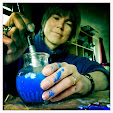I've just spent a week on Oronsay to see the barnacle geese before
they head north in mid-April. 2500 of these birds spend the winter on
the island. The mild west coast weather and sympathetic farm-
management by the RSPB, mean that there is fresh grass for them to
graze all through the winter. You can hear their distant cackling
from wherever you are on the island, and glimpse a speckled black and
white flock on many a distant field.
The prospect of drawing a huge group of milling stripy geese is a bit
daunting. I can see why their markings confuse predators, as it's
difficult to pick out individuals. They seem like a herd of zebras on
the island plains.
In March the cattle and sheep are taken off the in-by fields around
the house to allow corncrake habitat to grow up. The geese love the
fresh new growth on these ungrazed fields. I sit in the landrover
with a telescope and try to make sense of the flock. It's still a
struggle. As the sun gets lower I give up and retreat to warmth of
the farmhouse. Sitting at the kitchen table, gin and tonic to hand,
I watch as the geese graze ever nearer, until they are just outside
the window. This close, I can appreciate the delicate patterning of
individual birds, and work out how the feathers lie. The black and
white must give camouflage against the snow and rock of their nesting
grounds. It's hard to imagine that in a few weeks these back-yard
geese will be refuelling in Iceland en route to the wild Greenland
tundra.
When we open the back door last thing at night there's a noise like a
breaking wave as the flock takes off in the dark. Over the next few
weeks the small flocks will join together and their calling get
louder and louder as they wait for a wind from the south. Then
suddenly one morning the island will be quiet.















